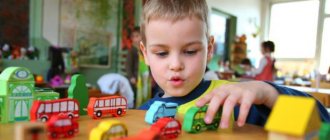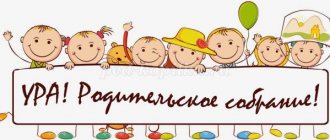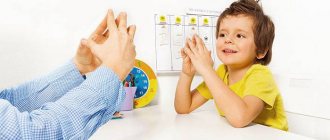MAGAZINE Preschooler.RF
Consultation for educators “SPEECH DEVELOPMENT THROUGH MUSIC”Municipal budgetary preschool educational institution kindergarten No. 11 of the municipality of the city of Goryachy Klyuch
Prepared by: Musical director A.N. Solodovnikova 2016
In recent years, there has been an increase in the number of children with speech disorders. One of the ways to develop the speech of preschool children is the systematic use of musical education.
The connection between music and speech is obvious: Musical sounds, like speech, are perceived by the ear.
The expressiveness of the language of music is similar to the expressiveness of speech.
Music, like speech, has an intonational nature. (The voice conveys the emotional state of a person using intonation coloring. And music, having intonation, expresses mood, character.)
Based on this, the combination of work on the speech of preschool children and the development of musical abilities is quite relevant.
Listening to music, singing, moving to music are the most enjoyable ways for children to learn. They develop the ability to distinguish sounds by ear, develop imagination and the ability to express their thoughts and emotions in words, as well as gestures and dance movements.
Let's take a closer look at different types of musical activities from the point of view of their effective impact on the development of children's speech.
Listening to music
Listening certainly forms auditory attention and emotional responsiveness to music; pitch, timbre and dynamic components of auditory perception.
It is necessary to separate passive and active perception when music influences the speech sphere of children. Passive perception has an activating effect and can be expressed in the musical arrangement of various games, accompanied by group activities, and in children’s independent activities that exclude verbal communication. Active perception is expressed, for example, in a conversation about a piece of music listened to. Such a conversation necessarily includes a description of the emotional and figurative content of the work and, therefore, allows you to expand the vocabulary of children, enrich it with various figurative words and expressions that characterize the feelings conveyed in music. It is useful, after listening to a piece of music and talking about it, to invite children to move to this music and convey its character, their feelings, and their attitude towards music in musical-rhythmic movements. (more on this later). When listening to music, the choice of repertoire is of great importance. Children's interest increases if:
- music works are united by a common story
-music the works belong to the work of one composer (several lessons) and in conclusion, the children were offered a musical and didactic game “Recognize and name the work”
-music works are compared in content and character, having similar or contrasting names.
Singing
This is definitely the type of muses. activities in which work on speech occurs most effectively. In singing, children show activity, a desire to sing, and experience pleasure from collective choral singing.
It is well known that singing develops breathing, voice, forms a sense of rhythm and tempo of speech, improves diction, and coordinates hearing and voice. Singing also helps correct speech deficiencies: slurred pronunciation, swallowing the endings of words, and singing in syllables helps automate the sound and reinforce correct pronunciation.
The main means of language acquisition and development of speech activity is repetition. And singing motivates children to repeat words and phrases in the most pleasant form: song verses and choruses. While receiving undeniable pleasure from singing performance activities, children do not realize that through repetition they learn words, as they sing them over and over again. This is why most children's song lyrics consist of repeated one-syllable words. Thus, singing by its nature excludes formal and mechanical repetition. Singing is always joy, a variety of emotions, a miracle of creativity!
In addition, songs provide learning of good language patterns that are easily produced because the speech flow is accompanied by music.
Another exclusive benefit of songs: songs have rhyme, and the ability to feel rhyme is an important skill for children, especially those who have speech problems. Unknowingly, an amazing educational activity takes place for children - learning the basics of poetry.
Let us briefly list a number of other advantages of singing activity for speech development:
-Singing helps to understand the rhythmic structure of the language, as children have to sing every syllable.
-Singing requires clearer articulation on the part of both the teacher and the children.
-By improving children’s vocal apparatus for singing, we are improving it for speech.
— By instilling in children a culture of expressive performance, we form speech expressiveness.
— Songs replenish children’s vocabulary and introduce them to new concepts.
-Songs develop in children the ability to consistently present facts, events, and phenomena.
— Songs that stimulate imaginative thinking are very useful for the development of speech activity.
— Singing in an ensemble or choir develops the ability to hear each other, work as a team, learn from each other and respect.
Musical and rhythmic movements
Musical rhythm certainly has a corrective effect on children’s speech. L. Generalov said: “Movement is also speech, expressing the essence of the child .
By accumulating musical and motor experience, correlating it with music of a different nature, children convey various musical and artistic images in free expressive movements.
For the development of children's speech, we note that it is important in this type of activity to train observation, develop a sense of rhythm, tempo and time, and develop general and fine motor skills.
A special role is played by exercises for the development of fine motor skills and hands - pole gymnastics to music. The connection between fine motor skills and speech skills has been established for a long time. E. Zheleznova proposed a technique for using finger games to music. It allows you to effectively solve problems of speech development.
Particular attention should be paid to logorhythmics. Logorhythmic exercises are another technique that relies on the connection between words, music and movement. It includes speech, music-motor and communication games. The goal of logorhythmic influence is to overcome and prevent speech disorders through the development, education and correction of the motor sphere in children in combination with words and music.
Logorhythmics tasks:
- development of auditory attention
- development of phonemic sense
- development of gross and fine motor skills, facial expressions, pantomime
- development of auditory-visual-motor coordination
- development of speech motor skills
- breathing development
Logorhythmic exercises are necessarily included in planning work on music education in groups of children with speech impairments. They invariably give a stable positive result.
Playing children's musical instruments
Learning to play children's musical instruments is one of the most interesting activities for children. Here children have the opportunity to show independence, activity, creativity, and overcome excessive shyness and constraint. This type of activity also solves the issues of developing fine motor skills (the importance of which we talked about in the musical-rhythmic movements section).
Special orchestral performing skills are associated with a child’s mastery of playing techniques on a particular instrument. At a younger age, these are mainly noise and percussion instruments (tambourines, wooden spoons, maracas, triangles). Creating noise orchestras is a wonderful means of developing not only the metrorhythmic sense, but also fine motor skills of children. After all, when a child produces a sound, he learns to control it not only with his hearing, but also with the force of his hand. Gradually, children master the ability to play instruments that have a scale. This greatly develops hearing, which in turn is important for activating the child’s speech. Therefore, it is very important to encourage children to listen to the sounds of a melody, compare them, distinguish them by pitch, thus accumulating invaluable auditory experience.
Thus, having analyzed all types of children's musical activities from the point of view of their role in the development of active speech in children, we draw a conclusion about the importance and special significance of each of them. Music classes provide children with a special atmosphere of creativity, encounters with beauty, and joy, so against a high emotional background, all fairly serious educational and developmental tasks are solved as effectively as possible. And the moment of naked didactics and training is simply impossible. We believe that the importance of musical education in the development of children’s speech is not sufficiently appreciated and is used by specialists in practice.
| Next > |




